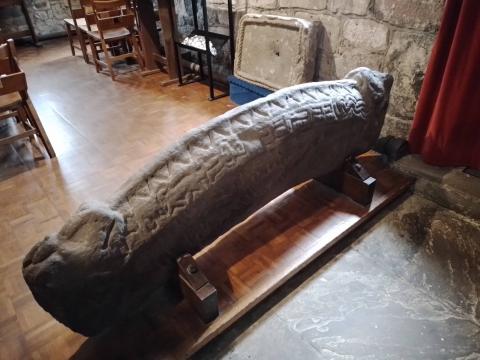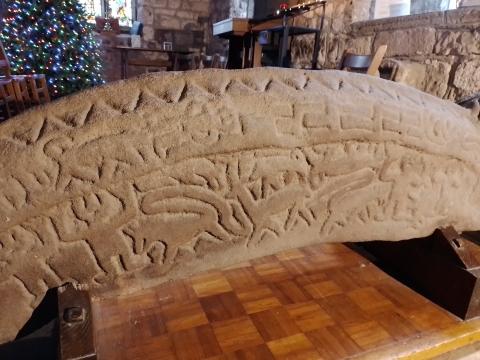Heysham's Hogback

At St Peter’s church at Heysham is a remarkable hogback tomb. Brought inside from the graveyard to better protect its ancient carvings, it sits serenely in the south chapel, with flood lights conveniently located to better enjoy it. Thor Ewing’s excellent academic assessment of the stone dates it to the tenth century, though the meaning of the figures is open to speculation: some see Christian imagery, some see it firmly within the tradition of Norse and Saxon paganism. On the first side is a man, who uncannily resembles a figure from a 1980s computer game. To his right is a tree, and to his left an animal, perhaps a wolf, offering him no obvious threat.

On the other side there are five humans, but the scene has rather more motion, with a hart and long-tailed wolves being hunted (or are they dogs assisting the hunt?). One poor chap is possibly being eaten by a wolf. There may be similarities with the early medieval tale of Sigmundr as told in the Old Icelandic Volsunga saga. The carvings reminded me of the Fall of Adam. On the one side of the hogback, he stands, strong yet peaceful, residing by the Tree of Life while the animal kingdom dwells contentedly at his feet. On the reverse, fallen Adam’s descendants are battling with a cursed earth; animals must be subdued, and they fight back; there is motion, commotion, bloodshed and death.

Seeing the fall of Adam depicted on a Saxon or Norse tomb might be thought fanciful, but the one who first lay beneath it learned only too well the dreadful legacy of Adam’s fall- by that one man, death entered the world. Yet by the last Adam’s work, the weak become strong, and access to the Tree of Life is once more made available.
When Adam by transgression fell,
And conscious, fled his Maker’s face,
Linked in clandestine league with hell,
He ruined all his future race:
The seeds of evil once brought in,
Increased and filled the world with sin.
But lo! the Second Adam came,
The serpent’s subtle head to bruise;
He cancels his malicious claim,
And disappoints his devilish views;
Ransoms poor prisoners with his blood,
And brings the sinner back to God.
J. Hart, No 89 in Gadsby's Hymns
- Log in to post comments


 Sunday Worship 10.45am & 6.00pm
Sunday Worship 10.45am & 6.00pm